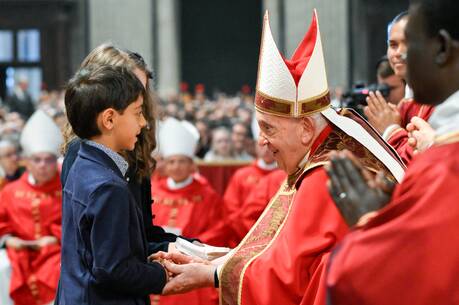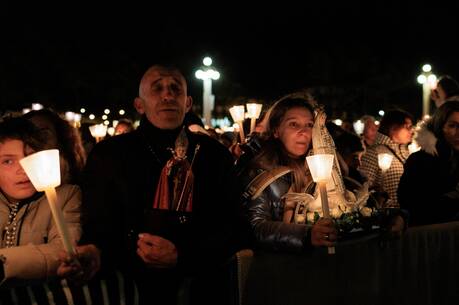The Costume Institute Benefit—better known as the Met Gala—took place on May 6 in New York City. The event has long been a stylized celebration of the sybaritic, with themes like “America: A Lexicon of Fashion” (2021), which showcased the trends in our own nation, or the queerly whimsical and fantastical “Camp: Notes on Fashion” (2019).
For a writer at a Catholic magazine (and perhaps our readers, too), nothing can quite compete with the 2018 theme “Heavenly Bodies: Fashion and the Catholic Imagination,” which explored the sacred and the secular (and America’s coverage was truly quite extensive). But this year’s Gala theme, “Sleeping Beauties: Reawakening Fashion” presented an opportunity for attendees to take a more environmentally conscious approach, one that might resonate with Pope Francis’ call to care for our common home. Andrew Bolton, the Wendy Yu Curator in Charge of the Costume Institute, told Vogue that the accompanying exhibit “is very much an ode to nature and the emotional poetics of fashion.”
Hundreds of celebrities turned out to walk the green carpet, but the gala’s dress code— “The Garden of Time”—inspired fewer environmentally conscious looks than I had hoped. The dress code came from the title of a 1962 short story by J.G. Ballard. In the story, a wealthy royal couple enjoys the splendor of their walled-in estate, including a magical rose garden, until an angry mob encroaches upon them. Each time the couple picks a magical rose from their garden, they turn back time, delaying the mob’s attack. But when the final rose has been cut, the couple must prepare for their doom.
It was an interesting choice: the gala’s organizers seemed to have no problem looking at themselves right in the eye. As Ballard’s short story shows, money and beauty cannot halt the destruction of the world. The gala—the very epitome of money and beauty—has the opportunity to be a space for celebrities to make a statement that goes beyond fashion. Their choices have the potential to promote a social cause at an event that is historically a celebration of fashion, not an arena for political statements. This year’s gala seemed primed for controversy, and yet none of that red-carpet activism, seen at other glitzy events like the Oscars, was present this year.
Few events draw as much scrutiny and pop culture frenzy. Thus, the way in which attendees choose to interpret the gala’s theme has the potential to illuminate a cultural or sociopolitical theme through their dress. But most celebrities at Monday night’s gala failed to push the boundaries of fashion. The gilded fanfare continued on, and while some attendees wore vintage or recycled materials, there was little attention paid to the environmental degradation taking place within the fashion industry at large, most especially in the new era of “fast fashion.”
Fast fashion, clothing items that are purchased at low prices and are poorly made, often in unsafe and unjust working conditions, is just one example of an industry thriving off the economic cycle of creation and destruction, meeting the demands of the market at the cost of the environment Pope Francis cautioned against this abuse in “Laudato Si’.” The encyclical focuses on caring for the natural environment, “Our Common Home” as Francis described it, as well as broader questions of the relationship between God, humans and the Earth.
Did Bolton have the encyclical in mind when pitching this year’s theme? Probably not. Interpreting the Met Gala can be complicated. The event is at once a call to a celebration of art and fashion’s rich history and a display of celebrities parading their wealth and people who, as the encyclical says, are likely “caught up in a whirlwind of needless buying and spending” (No. 203).
The fashion world is a cultural megaforce that allows self-expression through clothing for billions of people. The gala is a spectacle designed to be photographed on the museum’s staircase and commented about online by those who have even a casual interest in high fashion.
But it is not irredeemable. In some way, the existence of Monday night’s starry bash and its “Sleeping Beauties” on the carpet is a rebuff of the ever-burgeoning world of fast fashion. Many of the outfits were made from natural materials and were the result of the slow work of meticulous craftsmanship. Some celebrities donned archival designer pieces. The challenge of re-awakening a “sleeping beauty” design was channeled by supermodel Kendall Jenner who wore an archival 1999 Givenchy dress with a plunging neckline. Superstar and first-time gala co-host Zendaya stunned in not one but two red-carpet looks, aligned with the evening’s dress code in being vintage and rare. Women wore wigs, wings and, in one case, a wet t-shirt. Men wore black tuxedos, white tuxedos, or, in one case, a black tuxedo with a bedazzled turnip boutonniere.
Few celebrities went a more “sustainable” route: Demi Moore sported a blooming dress made of recycled wallpaper and Cara Delevigne wore a lab-grown, carbon-neutral diamond hooded bodice. These kinds of looks are just one component of the future of the fashion world, one that looks to the past to pioneer a more sustainable way forward.
In “Laudato Si,’” Pope Francis wrote that “a constant flood of new consumer goods can baffle the heart and prevent us from cherishing each thing and each moment” (No. 222). The Met Gala, when approached thoughtfully, presents us with an opportunity to cherish the beauty in the world, whether it is the craftsmanship of these attires or the art held in the museum. The event raises millions of dollars each year that benefit a cultural institution accessible to the masses. The event reminds us of the ways in which fashion and art and community intertwine to form our cultural fabric. That makes it all the more important that we use it to promote what is good. Fashion is an expression of our souls and how we express ourselves, but “our human ability to transform reality must proceed in line with God’s original gift of all that is (No. 9).” Fashion’s ability to “transform reality” must be met with the hope that God’s gift of “all that is” is more than a trend in the newest hemline, but instead a call to change the industry for the good of our common home.
America did not have a table at the event (though Anna Wintour did once tell Stephen Colbert that James Martin, S.J., was the best-dressed guest at her 2018 soirée), but I’ll keep watching fashion’s biggest night, albeit through my phone screen, every first Monday in May with the hope that the seeds of sustainable fashion planted at this year’s event might grow in future years.








